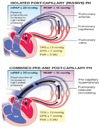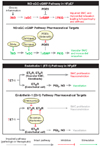Pulmonary vascular disease in the setting of heart failure with preserved ejection fraction
- PMID: 30177249
- PMCID: PMC6378124
- DOI: 10.1016/j.tcm.2018.08.005
Pulmonary vascular disease in the setting of heart failure with preserved ejection fraction
Abstract
Heart failure with preserved ejection fraction (HFpEF) is defined as clinical features of heart failure, ideally with biomarker evidence such as elevated plasma natriuretic peptide levels, in the setting of an ejection fraction (EF) greater than 50% and imaging evidence of diastolic left ventricular dysfunction [1,2]. In the absence of cardiac imaging or invasive hemodynamics, this is a clinical syndrome that is often indistinguishable from heart failure with reduced ejection fraction (HFrEF). HFpEF and HFrEF present with a cadre of comparable signs and symptoms including jugular venous distention, pulmonary rales on auscultation, breathlessness, orthopnea, exercise intolerance, exertional dyspnea, fatigue and peripheral edema. HFpEF accounts for at least half of all diagnoses of heart failure [1,2]. Pulmonary hypertension (PH) is a common complication of HFpEF that is linked to worse disease morbidity and mortality. In fact, mortality has been linked to increases in the intrinsic pulmonary vascular resistance in the setting of increased left ventricular end diastolic pressure, characterized hemodynamically by rises in the transpulmonary pressure gradient, pulmonary vascular resistance or diastolic pressure gradient. Despite being the most common form of PH, there are no approved therapies for the treatment of PH secondary to HFpEF. This review will summarize the hemodynamic classifications of PH in the setting of HFpEF, mechanisms of disease, the potential contribution of pulmonary vascular disease to poor outcomes in patients with HFpEF, and new approaches to therapy.
Keywords: HFpEF; PH-HFpEF; Pulmonary Hypertension.
Copyright © 2018 Elsevier Inc. All rights reserved.
Conflict of interest statement
COI:
Andrea R. Levine: none
Figures




Comment in
-
Editorial commentary: Pulmonary hypertension in left heart disease: Definitions, data sources, and the road ahead.Trends Cardiovasc Med. 2019 May;29(4):218-219. doi: 10.1016/j.tcm.2018.09.013. Epub 2018 Sep 20. Trends Cardiovasc Med. 2019. PMID: 30279040 No abstract available.
Similar articles
-
Association Between Hemodynamic Markers of Pulmonary Hypertension and Outcomes in Heart Failure With Preserved Ejection Fraction.JAMA Cardiol. 2018 Apr 1;3(4):298-306. doi: 10.1001/jamacardio.2018.0128. JAMA Cardiol. 2018. PMID: 29541759 Free PMC article.
-
Hemodynamic Phenotyping of Pulmonary Hypertension in Left Heart Failure.Circ Heart Fail. 2017 Sep;10(9):e004082. doi: 10.1161/CIRCHEARTFAILURE.117.004082. Circ Heart Fail. 2017. PMID: 28912263 Review.
-
Insights into the pulmonary vascular complications of heart failure with preserved ejection fraction.J Physiol. 2019 Feb;597(4):1143-1156. doi: 10.1113/JP275858. Epub 2018 Dec 30. J Physiol. 2019. PMID: 30549058 Free PMC article. Review.
-
Enhanced pulmonary vasodilator reserve and abnormal right ventricular: pulmonary artery coupling in heart failure with preserved ejection fraction.Circ Heart Fail. 2015 May;8(3):542-50. doi: 10.1161/CIRCHEARTFAILURE.114.002114. Epub 2015 Apr 9. Circ Heart Fail. 2015. PMID: 25857307 Clinical Trial.
-
RV Contractile Function and its Coupling to Pulmonary Circulation in Heart Failure With Preserved Ejection Fraction: Stratification of Clinical Phenotypes and Outcomes.JACC Cardiovasc Imaging. 2017 Oct;10(10 Pt B):1211-1221. doi: 10.1016/j.jcmg.2016.12.024. Epub 2017 Apr 12. JACC Cardiovasc Imaging. 2017. PMID: 28412423
Cited by
-
Current Understanding of Circulating Biomarkers in Pulmonary Hypertension Due to Left Heart Disease.Front Med (Lausanne). 2020 Oct 7;7:570016. doi: 10.3389/fmed.2020.570016. eCollection 2020. Front Med (Lausanne). 2020. PMID: 33117832 Free PMC article. Review.
-
Treatment With Treprostinil and Metformin Normalizes Hyperglycemia and Improves Cardiac Function in Pulmonary Hypertension Associated With Heart Failure With Preserved Ejection Fraction.Arterioscler Thromb Vasc Biol. 2020 Jun;40(6):1543-1558. doi: 10.1161/ATVBAHA.119.313883. Epub 2020 Apr 9. Arterioscler Thromb Vasc Biol. 2020. PMID: 32268788 Free PMC article.
-
Pulmonary gas exchange in relation to exercise pulmonary hypertension in patients with heart failure with preserved ejection fraction.Eur Respir J. 2025 Feb 13;65(2):2400722. doi: 10.1183/13993003.00722-2024. Print 2025 Feb. Eur Respir J. 2025. PMID: 39510552 Free PMC article.
-
Sotatercept analog improves cardiopulmonary remodeling and pulmonary hypertension in experimental left heart failure.Front Cardiovasc Med. 2023 Feb 23;10:1064290. doi: 10.3389/fcvm.2023.1064290. eCollection 2023. Front Cardiovasc Med. 2023. PMID: 36910526 Free PMC article.
-
Higher plasma IL-6 and PTX3 are associated with worse survival in left heart failure with pulmonary hypertension.Am Heart J Plus. 2022 Aug 10;20:100190. doi: 10.1016/j.ahjo.2022.100190. eCollection 2022 Aug. Am Heart J Plus. 2022. PMID: 38560419 Free PMC article.
References
-
- Dunlay SM, Roger VL, Redfield MM. Epidemiology of heart failure with preserved ejection fraction. Nat Rev Cardiol. 2017. October;14(10):591–602. - PubMed
-
- Galiè N, Humbert M, Vachiery J-L, Gibbs S, Lang I, Torbicki A, et al. 2015 ESC/ERS Guidelines for the diagnosis and treatment of pulmonary hypertension: The Joint Task Force for the Diagnosis and Treatment of Pulmonary Hypertension of the European Society of Cardiology (ESC) and the European Respiratory Society (ERS): Endorsed by: Association for European Paediatric and Congenital Cardiology (AEPC), International Society for Heart and Lung Transplantation (ISHLT). Eur Heart J. 2016. January 1;37(1):67–119. - PubMed
-
- Fang JC, DeMarco T, Givertz MM, Borlaug BA, Lewis GD, Rame JE, et al. World Health Organization Pulmonary Hypertension group 2: pulmonary hypertension due to left heart disease in the adult--a summary statement from the Pulmonary Hypertension Council of the International Society for Heart and Lung Transplantation. J Heart Lung Transplant. 2012. September;31(9):913–33. - PubMed
-
- Opitz CF, Hoeper MM, Gibbs JSR, Kaemmerer H, Pepke-Zaba J, Coghlan JG, et al. Pre-Capillary, Combined, and Post-Capillary Pulmonary Hypertension: A Pathophysiological Continuum. J Am Coll Cardiol. 2016. July 26;68(4):368–78. - PubMed
Publication types
MeSH terms
Grants and funding
LinkOut - more resources
Full Text Sources
Other Literature Sources
Medical

